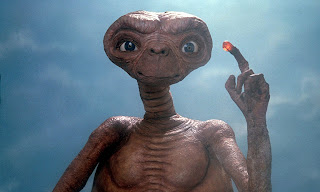 |
| Fig 1: Poster |
Steven Spielberg's ET. The Extra-Terrestrial (1982) is a adventure, drama, sci-fi and family movie. The film tells a story about a gentle and shy alien accidentally being left behind on Earth. He is found by a ten year old boy named Elliot and after a while they start to communicate and become friends. Elliot takes the alien in, naming him E.T. and keeps him hidden from adults with the help of his older brother and younger sister. E.T seems to learn fast and short after starting to talk, he asks Elliot to help him 'phone' home. They both get sick and the government discovered the alien hidden in the home, completely taking over the house. With the help of some friend Elliot and E.T. both escape and as the spaceship returns to Earth the two friends say their last, tearful goodbye.
This movie is considered to be a family movie, mostly aimed for children and younger people, but it is similarly enjoyed by adults, as the whole film is filled with joyful and cute scenes. As said by Robert Ebert "It is filled with innocence, hope, and good cheer...It tells a story about friendship and love...It works as science fiction, it's sometimes as scary as a monster movie, and at the end, when the lights go up, there's not a dry eye in the house." (Ebert, 2002) The film is heavily shot and portrayed by a child's perspective (as often seen by the height of the camera, which appears to be at the level of a younger child) and most adults are only shown in a threatening way; hardly any faces shown, but rather adults are only seen from the waist down. This perspective helps reflecting the curious and innocent nature of young kids and overall the film has a very heartwarming tone. E.T.'s childish behaviour and Elliot's enthusiasm to help the friendly creature instantly make their friendship look way more adorable and makes the final scene that more of a heartbreak. Some moments make us feel happy and adore characters, others make us desperate to be able to help them. Overall the whole film has a wondrous an innocent feel, with lovable characters and a ending that make the audience both sad with tears and happy at the same time.
 |
| Fig 3: E.T. and Elliot saying goodbye |
The film's alien E.T. was not the product of CGI, but was a puppet, which meant that the whole presence of the creature would feel more real, however unmistakably just a puppet. Sometimes it might be very obvious that the puppet is moved by a machine and not be a person judging by the rigid movements. However, the lack of smooth movements and the clear knowledge that it is only a puppet does not change the fact that E.T. is still very lovable. Stated in a article "...the creators of E.T. strived to design their alien to be as empathetic as possible. With empathy comes believability, the line between suspension of disbelief and outright audience immersion blurred as an artificial creation is transformed into a realistic on-screen personality even if, on a conscious level, the viewer knows the creature is simply a visual effect." (s.n., 2010) The creators were able to sell the character/puppet to the audience with a cute and innocent personality. As the audience is presented with the curious and friendly little creature, they are able to ignore the knowledge of it not being real, and the see the movie 'believing' that it is a real alien.
 |
| Fig 4: E.T. |
This movie is also praised for its music and soundtracks, which were written by John Williams. As said in an article "John Williams’ score is also significant here, as it is throughout the film, building from a sombre sketch of the film’s fantasy theme played as a flute solo evoking a sense of wondrous alienation before the sound of a harp invites the other sections of the orchestra to subtly enter the soundtrack just as the orb-like alien spaceship is shown on the forest ground." (s.n., 2010) The music is not only there to fill some quiet moments, but it communicates actions and events and successfully sets up the atmosphere the director wanted the audience to feel. When the actions are calm and the focus is wanted on a specific character or event, the music softens down, however when the scene is heavy with action and the aim is to get the audience at the edge of their seats, the music picks up, with more instruments, louder volume and quicker pace.
Bibliography:
- Dyer, J. (2013) E.T. The Extra-Terrestrial – Esoteric Analysis. At: https://jaysanalysis.com/2013/07/22/e-t-the-extra-terrestrial-esoteric-analysis/ (Accessed on 30.03.17)
- Ebert, R. (2002) E.T. THE EXTRA-TERRESTRIAL. At: http://www.rogerebert.com/reviews/et-the-extra-terrestrial-2002 (Accessed on 30.03.17)
- Filmtracks (2008) E.T. The Extra-Terrestrial. At: http://www.filmtracks.com/titles/et.html (Accessed on 30.03.17)
- s.n. (2010) Analysis of ‘E.T. The Extra-Terrestrial’ (1982). At: https://markwpage.wordpress.com/2010/02/24/analysis-of-e-t-the-extra-terrestrial-1982/ (Accessed on 30.03.17)
Illustration List:
- Figure 1: Poster (s.d.) [Poster] At: http://www.moviepostershop.com/et--the-extra-terrestrial-movie-poster-1982 (Accessed on 30.03.17)
- Figure 2: Elliot and E.T. (2014) [Film Still] At: https://wall.alphacoders.com/big.php?i=466322&lang=Swedish (Accessed on 30.03.17)
- Figure 3: E.T. and Elliot saying goodbye (s.d.) [Gif/Online] At: https://img.gifamerica.com/8166797a95a517edefabe4ea63a3b47e_phone-home-gif-et-et-home-gif_497-280.gif (Accessed on 30.03.17)
- Figure 4: E.T. (2016) [Online] At: http://hu.ign.com/movies/17981/feature/eletunk-legremuletesebb-filmelmenyei (Accessed on 30.03.17)

No comments:
Post a Comment